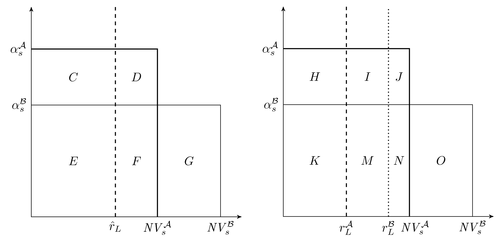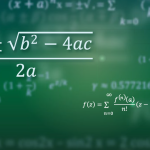An illustration inspired by a figure in Bebczuk, Ricardo N. (2003). Asymmetric Information in Financial Markets: Introduction and Applications. Cambridge University Press.

Edit and compile if you like:
% Author: Rasmus Pank Roulund
% Inspired by figure in:
% Bebczuk, Ricardo N. (2003). Asymmetric Information in Financial
% Markets: Introduction and Applications. Cambridge University Press.
\documentclass{minimal}
\usepackage{tikz}
\usetikzlibrary{arrows,calc}
\tikzset{
%Define standard arrow tip
>=stealth',
%Define style for different line styles
help lines/.style={dashed, thick},
axis/.style={<->},
important line/.style={thick},
connection/.style={thick, dotted},
}
\newcommand\A{\ensuremath{\mathcal{A}}}
\newcommand\B{\ensuremath{\mathcal{B}}}
\begin{document}
\begin{tikzpicture}[scale=1.2]
%Draw axis
\coordinate (y) at (0,5);
\coordinate (x) at (5,0);
\draw[axis] (y) -- (0,0) -- (x);
%Important coordinates. These are used in both figures and can be
%moved to a seperate settings files
%% These coordinates deside where boxes start on the y axis
\coordinate (alphaas) at ($0.8*(y)$);
\coordinate (alphabs) at ($0.533*(y)$);
%% These coordinates deside where boxes end on the x axis
\coordinate (cfas) at ($.6*(x)$);
\coordinate (cfbs) at ($.9*(x)$);
%These sets the interest rate lines
\coordinate (rl) at ($(cfas)-.2*(x)$);
\coordinate (rla) at ($(rl)-.1*(x)$);
\coordinate (rlb) at ($(rl)+.1*(x)$);
%%%%%%%%%%%%%%%%%%%%%%
%We makes some boxes and connect some coordinates
%%%%%%%%%%%%%%%%%%%%%%
%First, let us draw a line connecting alpha^\A_s og NV^\A_s
\draw[important line] let \p1=(alphaas), \p2=(cfas) in
(\p1) node[left] {$\alpha_s^\A$} -| (\x2, \y1) -| (\p2)
node[below] {$\mathit{NV^\A_s}$};
%Second, let us connect alpha^\B_s og NV^B_s
\draw[] let \p1=(alphabs), \p2=(cfbs) in
(\p1) node[left] {$\alpha_s^\B$} -| (\x2, \y1) -| (\p2)
node[below] {$\mathit{NV^\B_s}$};
%A line seperating the boxes.
\draw[help lines] let \p1=(rl), \p2=(y) in
(\p1) node[below] {$\hat{r}_L$} -- (\x1, \y2);
%%%%%%%%%%%%%%%%%%%%%%
%The small boxes will be assinged letter
%%%%%%%%%%%%%%%%%%%%%%
%%C
\draw let \p1=($(alphaas)-(alphabs)$), \p2=(rl), \p3=(alphabs) in
($(.5*\x2, .5*\y1+\y3)$) node {$C$};
%%D
\draw let \p1=($(alphaas)-(alphabs)$), \p2=($(cfas)-(rl)$),
\p3=(alphabs), \p4=(rl) in
($(.5*\x2+\x4, .5*\y1+\y3)$) node {$D$};
%%E
\draw let \p1=(alphabs), \p2=(rl) in
($(.5*\x2, .5*\y1)$) node {$E$};
%%F
\draw let \p1=(alphabs), \p2=($(cfas)-(rl)$), \p3=(rl) in
($(.5*\x2+\x3, .5*\y1)$) node {$F$};
%%G
\draw let \p1=(alphabs), \p2=($(cfbs)-(cfas)$), \p3=(cfas) in
($(.5*\x2+\x3, .5*\y1)$) node {$G$};
\end{tikzpicture}
\quad
\begin{tikzpicture}[scale=1.2]
%Axis
\coordinate (y) at (0,5);
\coordinate (x) at (5,0);
\draw[axis] (y) -- (0,0) -- (x);
%Important coordinates. These are used in both figures and can be
%moved to a seperate settings files
%% These coordinates deside where boxes start on the y axis
\coordinate (alphaas) at ($0.8*(y)$);
\coordinate (alphabs) at ($0.533*(y)$);
%% These coordinates deside where boxes end on the x axis
\coordinate (cfas) at ($.6*(x)$);
\coordinate (cfbs) at ($.9*(x)$);
%These sets the interest rate lines
\coordinate (rl) at ($(cfas)-.2*(x)$);
\coordinate (rla) at ($(rl)-.1*(x)$);
\coordinate (rlb) at ($(rl)+.1*(x)$);
%%%%%%%%%%%%%%%%%%%%%%
%We makes some boxes and connect some coordinates
%%%%%%%%%%%%%%%%%%%%%%
%First, let us draw a line connecting alpha^\A_s og NV^\A_s
\draw[important line] let \p1=(alphaas), \p2=(cfas) in
(\p1) node[left] {$\alpha_s^\A$} -| (\x2, \y1) -| (\p2)
node[below] {$\phantom{N}\mathit{NV^\A_s}$};
%Second, let us connect alpha^\B_s og NV^B_s
\draw[] let \p1=(alphabs), \p2=(cfbs) in
(\p1) node[left] {$\alpha_s^\B$} -| (\x2, \y1) -| (\p2)
node[below] {$\mathit{NV^\B_s}$};
%%%%%%%%%%%%%%%%%%%%%%
%Here we need two lines seperating the large boxes
%%%%%%%%%%%%%%%%%%%%%%
\draw[help lines] let \p1=(rla), \p2=(y) in
(\p1) node[below] {$r^\A_L$} -- (\x1, \y2);
\draw[connection] let \p1=(rlb), \p2=(y) in
(\p1) node[below] {$r^\B_L$} -- (\x1, \y2);
%%%%%%%%%%%%%%%%%%%%%%
%The small boxes will be assinged letter
%%%%%%%%%%%%%%%%%%%%%%
%%H
\draw let \p1=($(alphaas)-(alphabs)$), \p2=(rla), \p3=(alphabs) in
($(.5*\x2, .5*\y1+\y3)$) node {$H$};
%%I
\draw let \p1=($(alphaas)-(alphabs)$), \p2=($(rlb)-(rla)$),
\p3=(alphabs), \p4=(rla) in
($(.5*\x2+\x4, .5*\y1+\y3)$) node {$I$};
%%J
\draw let \p1=($(alphaas)-(alphabs)$), \p2=($(cfas)-(rlb)$),
\p3=(alphabs), \p4=(rlb) in
($(.5*\x2+\x4, .5*\y1+\y3)$) node {$J$};
%%K
\draw let \p1=(alphabs), \p2=(rla) in
($(.5*\x2, .5*\y1)$) node {$K$};
%%M
\draw let \p1=(alphabs), \p2=($(rlb)-(rla)$), \p3=(rla) in
($(.5*\x2+\x3, .5*\y1)$) node {$M$};
%%N
\draw let \p1=(alphabs), \p2=($(cfas)-(rlb)$), \p3=(rlb) in
($(.5*\x2+\x3, .5*\y1)$) node {$N$};
%%O
\draw let \p1=(alphabs), \p2=($(cfbs)-(cfas)$), \p3=(cfas) in
($(.5*\x2+\x3, .5*\y1)$) node {$O$};
\end{tikzpicture}
\end{document}
%%% Local Variables:
%%% mode: latex
%%% TeX-master: t
%%% End:
Click to download: asymmetric-information.tex • asymmetric-information.pdf
Open in Overleaf: asymmetric-information.tex

